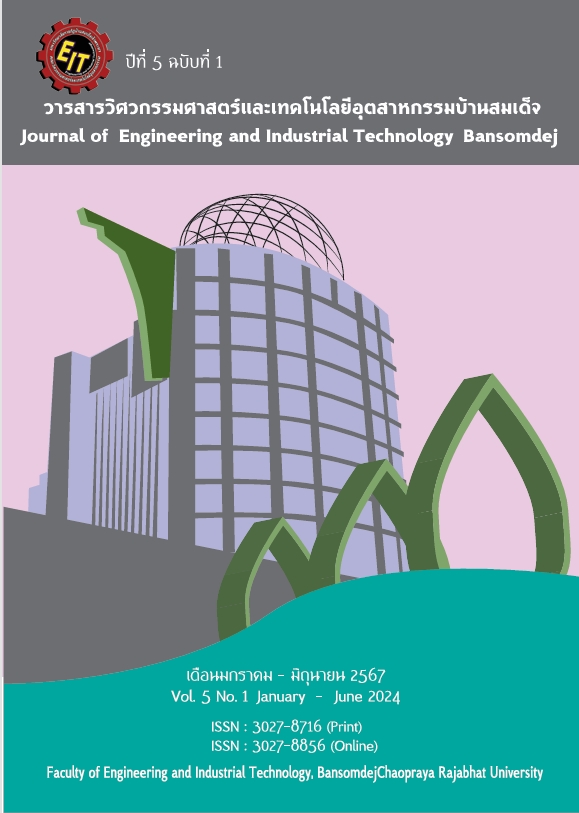Study of non-contact body temperature sensors for initial patient screening
Main Article Content
Abstract
The objectives of this research are 1. to design and build a non-contact body temperature measurement system, 2. to study the error percentage of non-contact body temperature measurement sensors. The equipment used in the research consists of 1) Arduino UNO R3 board, 2) GY - 906 temperature sensor, and 3) LCD display screen. The temperature measurement experiment will start from a distance of 2 centimeters by increasing the distance by 2 centimeters up to 20 centimeters and testing 10 times per distance. Then calculate the percentage error of each distance. The experiment determines and controls the variables of temperature, brightness, and measurement position to be constant and appropriate to obtain accurate experimental results. The results of the experiment showed that the temperature monitoring system can work continuously, all parts can be disassembled for ease of movement, and the total cost of creating the workpiece is cheap. The work of the temperature sensor found that the distance that can measure the most accurately is 10 centimeters with an error of 0.06%. A suggestion for future research should be to experiment with comparisons with other models of temperature sensors in order to know the accuracy of various models of sensors that are commercially available, and to apply temperature sensors to monitoring systems, and prevent infection with the 2019 coronavirus by working with Internet of Things technology in other ways.
Article Details
References
กองโรคจากการประกอบอาชีพและสิ่งแวดล้อม กรมควบคุมโรค กระทรวงสาธารณสุข. (2563). แนวทางการ
ดำเนินการเรื่อง โรคติดเชื้อไวรัสโคโรนา 2019 สำหรับสถานประกอบการ. สืบค้นเมื่อวันที่ 3 กุมภาพันธ์2567 จาก https://ddc.moph.go.th/doed/journal_detail.php?publish=9984
กองวิศวกรรมการแพทย์. (2556). คู่มือ การจัดระบบวิศวกรรมการแพทย์ในโรงพยาบาล ปี 2556. สืบค้นเมื่อวันที่
กุมภาพันธ์ 2567 จาก https://www.tfh.go.th/tfh/wp-content/uploads/2017/06/20-บทที่-16-ค่าผิดพลาดที่ยอมรับได้.pdf
คณะกรรมการกิจการกระจายเสียง กิจการโทรทัศน์ และกิจการโทรคมนาคมแห่งชาติ. (2561). เทคโนโลยี
Internet of Things และนโยบาย Thailand 4.0. สืบค้นเมื่อวันที่ 9 กุมภาพันธ์ 2567 จาก https://www.nbtc.go.th/Services/quarter2560/%E0%B8%9B%E0%B8%B5-2561/32279.aspx
สุรเทพ แป้นเกิด วาสนา ด้วงเหมือน และสุภษี ดวงใส. (2565). เครื่องต้นแบบในการบันทึกสัญญาณชีพ ด้วย
อินเทอร์เน็ตของสรรพสิ่ง. วารสารวิชาการการประยุกต์ใช้เทคโนโลยีสารสนเทศ. ปีที่ 8 (ฉบับที่ 2), 17-27
Merchant, J. (2017). Infrared Temperature Measurement Theory and Application. สืบค้นเมื่อวันที่ 9
กุมภาพันธ์ 2567 จาก https://thermalprocessing.com/wpcontent/uploads/2017/201703 /0317-TP.pdf
Mnati, M. J., Chisab, R. F., Al-Rawi, A. M., Ali, A. H., & Van den Bossche, A. (2021). An open-source
non-contact thermometer using low-cost electronic components. HardwareX, 9, e00183. https://doi.org/10.1016/j.ohx.2021.e00183
Piccinini, F. Martinelli, G. Carbonaro, A. (2021). Reliability of Body Temperature Measurements
Obtained with Contactless Infrared Point Thermometers Commonly Used during the
COVID-19 Pandemic, Sensors, 21, 3794. https://doi.org/10.3390/s21113794


